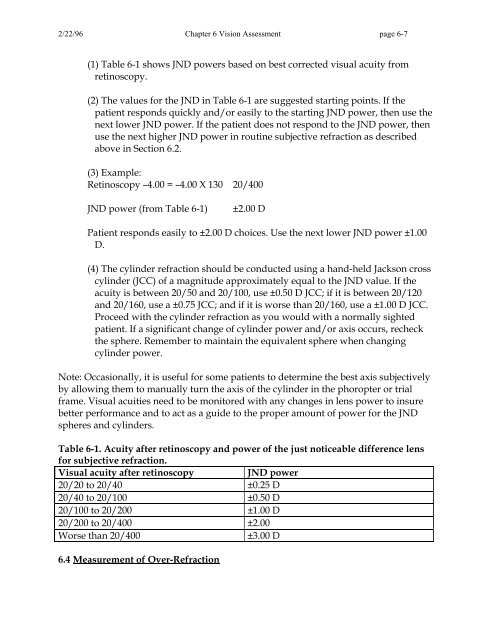OM t of c.iii - Vision Research Coordinating Center - Washington ...
OM t of c.iii - Vision Research Coordinating Center - Washington ...
OM t of c.iii - Vision Research Coordinating Center - Washington ...
Create successful ePaper yourself
Turn your PDF publications into a flip-book with our unique Google optimized e-Paper software.
2/22/96 Chapter 6 <strong>Vision</strong> Assessment page 6-7<br />
(1) Table 6-1 shows JND powers based on best corrected visual acuity from<br />
retinoscopy.<br />
(2) The values for the JND in Table 6-1 are suggested starting points. If the<br />
patient responds quickly and/or easily to the starting JND power, then use the<br />
next lower JND power. If the patient does not respond to the JND power, then<br />
use the next higher JND power in routine subjective refraction as described<br />
above in Section 6.2.<br />
(3) Example:<br />
Retinoscopy –4.00 = –4.00 X 130 20/400<br />
JND power (from Table 6-1)<br />
±2.00 D<br />
Patient responds easily to ±2.00 D choices. Use the next lower JND power ±1.00<br />
D.<br />
(4) The cylinder refraction should be conducted using a hand-held Jackson cross<br />
cylinder (JCC) <strong>of</strong> a magnitude approximately equal to the JND value. If the<br />
acuity is between 20/50 and 20/100, use ±0.50 D JCC; if it is between 20/120<br />
and 20/160, use a ±0.75 JCC; and if it is worse than 20/160, use a ±1.00 D JCC.<br />
Proceed with the cylinder refraction as you would with a normally sighted<br />
patient. If a significant change <strong>of</strong> cylinder power and/or axis occurs, recheck<br />
the sphere. Remember to maintain the equivalent sphere when changing<br />
cylinder power.<br />
Note: Occasionally, it is useful for some patients to determine the best axis subjectively<br />
by allowing them to manually turn the axis <strong>of</strong> the cylinder in the phoropter or trial<br />
frame. Visual acuities need to be monitored with any changes in lens power to insure<br />
better performance and to act as a guide to the proper amount <strong>of</strong> power for the JND<br />
spheres and cylinders.<br />
Table 6-1. Acuity after retinoscopy and power <strong>of</strong> the just noticeable difference lens<br />
for subjective refraction.<br />
Visual acuity after retinoscopy<br />
JND power<br />
20/20 to 20/40 ±0.25 D<br />
20/40 to 20/100 ±0.50 D<br />
20/100 to 20/200 ±1.00 D<br />
20/200 to 20/400 ±2.00<br />
Worse than 20/400<br />
±3.00 D<br />
6.4 Measurement <strong>of</strong> Over-Refraction
















